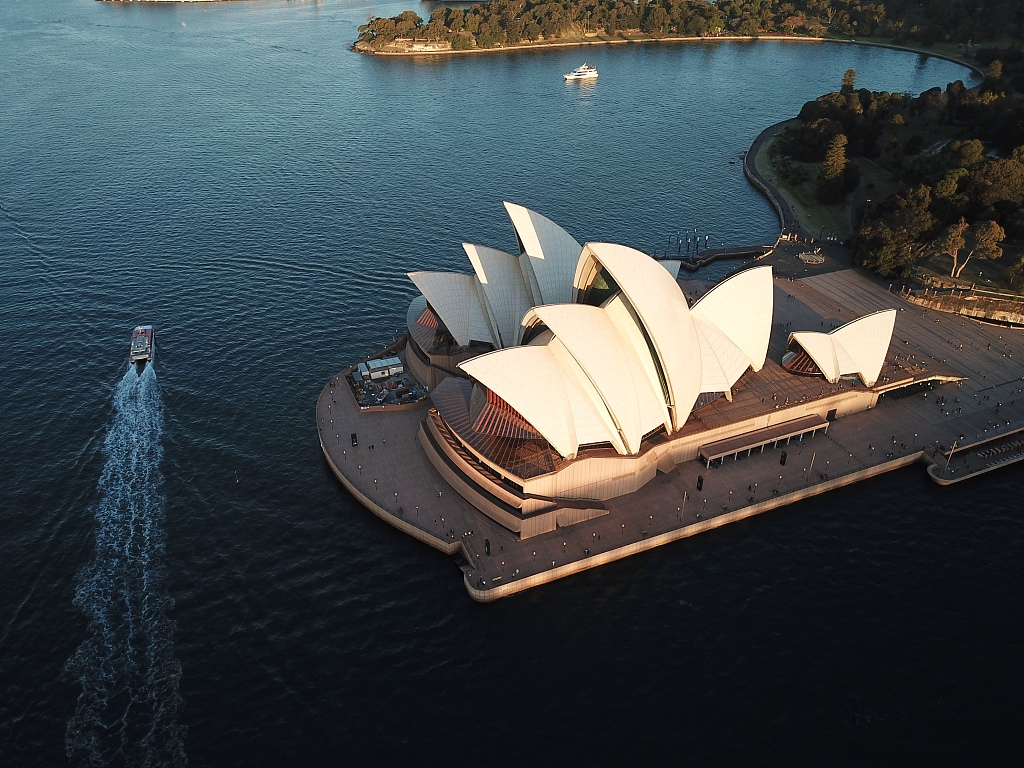
The national flag and the flag of New South Wales state, a southeastern Australian state, flutter over the Sydney Harbour Bridge in Australia, February 3, 2019. /VCG Photo
The national flag and the flag of New South Wales state, a southeastern Australian state, flutter over the Sydney Harbour Bridge in Australia, February 3, 2019. /VCG Photo
Editor's Note: Tom Fowdy is a British political and international relations analyst and a graduate of Durham and Oxford universities. He writes on topics pertaining to China, the DPRK, Britain, and the United States. The article reflects the author's opinions, and not necessarily the views of CGTN.
On October 23, the premier of Australia's Victoria State, Daniel Andrews, signed up to China's Belt and Road Initiative in Beijing. In doing so, his province became the first part of Australia to officially join the program, with Andrews looking to get Chinese companies involved in a huge local infrastructure push what he describes as Victoria's "Big Build," as well as a vision for local construction companies to play role in building projects throughout the wider BRI.
On joining, Andrews stated: "We need a strong partnership, Victoria has one, and we would hope that every state and territory and indeed the Commonwealth would have a strong partnership and a friendship with China," further stating that he believed the scheme would give "Victorian companies an edge." The agreement also pledges cooperation in manufacturing, agriculture and technology.
Inevitably, given the political climate in Australia, the announcement was met with disapproval from national level politicians in Canberra who proceeded to question whether the move was truly in the country's national interest.
However, Victoria is not the only one, with the Northern Territory also voicing its support for the BRI and considering joining, with its Chief Minister Michael Gunner also pledging cooperation with China in a speech last week.
What does this tell us? It tells us that despite the growing climate of Sinophobia in Australian politics, growing trade and investment ties with China ultimately remains in the country's national interest and at a state level, such incentives are seen as welcome and necessary, creating a clear divide between regional politicians and national level ones, who are more likely to view things through a security perspective and the position of the United States.
Still, Canberra simply cannot deny the realities of geography. It is unrealistic to anticipate the country can politically isolate itself from its largest trading partner, and wider regional trends such as the BRI.
Over the past couple of years, Australia's ties with China have soured somewhat. The government in Canberra have pursued a pushback in Beijing in tandem with the United States; this has produced a nationally led climate of hysteria against the country under the mantra of the "China threat."
This has led to ethnic Chinese politicians and university students regularly scapegoated as sources of "influence." Australia would also move to ban Huawei from its 5G internet network, champion America's "free and open Indo-Pacific," exaggerate Beijing's "military ambitions" and so on.

The Sydney Opera House at Sydney Harbour in Sydney, New South Wales, Australia, August 17, 2018. /VCG Photo
The Sydney Opera House at Sydney Harbour in Sydney, New South Wales, Australia, August 17, 2018. /VCG Photo
However, owing to the realities of simple geography, Australia nevertheless finds it still has to uphold a stable relationship with China. Beijing remains Canberra's largest trading partner, its largest source of overseas foreign direct investment, its largest source of foreign tourists and largest source of international students.
This has subsequently produced divisions in the country's China debate which has stopped things from deteriorating as badly as Washington, with an underlying recognition present that Australia has a great deal to lose from exacerbated conflict with Beijing.
Given this, some areas of Australian society want to embrace China more whilst others are trying to push back. The friction between state governments and the national government over the BRI is a clear example.
Unlike the national government, state governments are not influenced by overseas diplomatic considerations such as the demands of the United States, instead they focus more on local development, investment and jobs growth.
As a result, state governments in Australia can see the clear gains and opportunities provided by participating in the Belt and Road Initiative, whereby the national government is more inclined to see it in terms of pure politics.
However, it is absolutely important that Canberra understands, rather than moves to condemn the decision of state level officials.
Given this, the idea that Australia can simply isolate itself from the region's, and for that matter the world's, biggest infrastructure and trade connectivity program is simply not realistic or productive. The country's national economic interests mandate its participation, and this is why despite the hysteria at the national level, state level governments are now unavoidably gravitating towards it.
This leaves Canberra with a choice: It can either join the BRI as a country and coordinate a national level strategy on how to uphold and project Australia's interests within the program, or it can continue to object to it at Washington's insistence and in turn be pulled into it indirectly by the role of state governments and have an incoherent, divided approach which weakens their hand.
As a whole, Canberra needs to look at this and act pragmatically to the fact that China will continue to play an irreplaceable role in the country's economy. It is a simple implication of geography, and this is why their state governments are signing up.
(If you want to contribute and have specific expertise, please contact us at opinions@cgtn.com.)